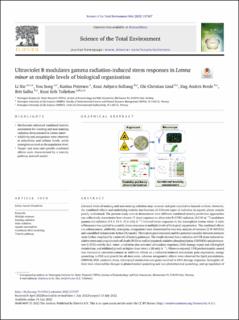| dc.description.abstract | Elevated levels of ionizing and non-ionizing radiation may co-occur and pose cumulative hazards to biota. However, the combined effects and underlying toxicity mechanisms of different types of radiation in aquatic plants remain poorly understood. The present study aims to demonstrate how different combined toxicity prediction approaches can collectively characterise how chronic (7 days) exposure to ultraviolet B (UVB) radiation (0.5 W m−2) modulates gamma (γ) radiation (14.9, 19.5, 43.6 mGy h−1) induced stress responses in the macrophyte Lemna minor. A suite of bioassays was applied to quantify stress responses at multiple levels of biological organisation. The combined effects (no-enhancement, additivity, synergism, antagonism) were determined by two-way analysis of variance (2 W-ANOVA) and a modified Independent Action (IA) model. The toxicological responses and the potential causality between stressors were further visualised by a network of toxicity pathways. The results showed that γ-radiation or UVB alone induced oxidative stress and programmed cell death (PCD) as well as impaired oxidative phosphorylation (OXPHOS) and photosystem II (PSII) activity in L. minor. γ-radiation also activated antioxidant responses, DNA damage repair and chlorophyll metabolism, and inhibited growth at higher dose rates (≥20 mGy h−1). When co-exposed, UVB predominantly caused non-interaction (no-enhancement or additive) effects on γ-radiation-induced antioxidant gene expression, energy quenching in PSII and growth for all dose rates, whereas antagonistic effects were observed for lipid peroxidation, OXPHOS, PCD, oxidative stress, chlorophyll metabolism and genes involved in DNA damage responses. Synergistic effects were observed for changes in photochemical quenching and non-photochemical quenching, and up-regulation of antioxidant enzyme genes (GST) at one or more dose rates, while synergistic reproductive inhibition occurred at all three γ-radiation dose rates. The present study provides mechanistic knowledge, quantitative understanding and novel analytical strategies to decipher combined effects across levels of biological organisation, which should facilitate future cumulative hazard assessments of multiple stressors. | |
